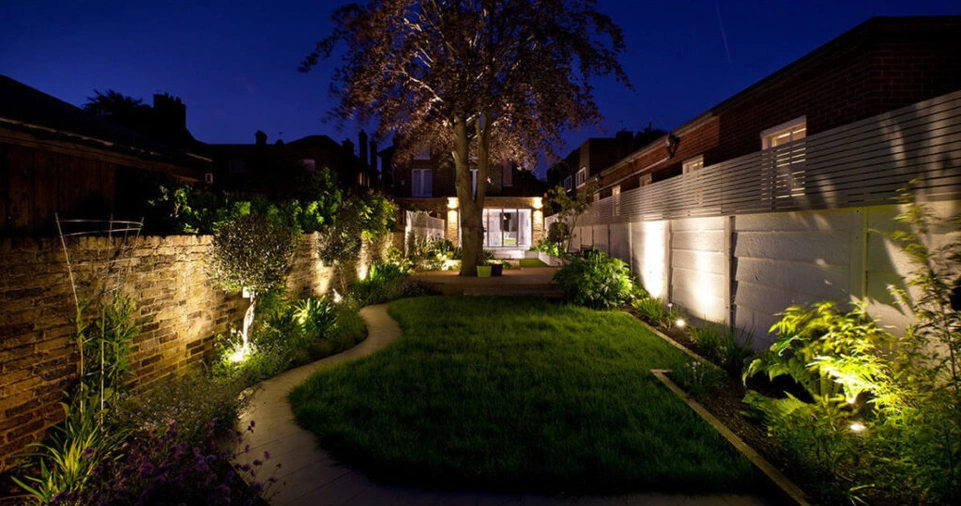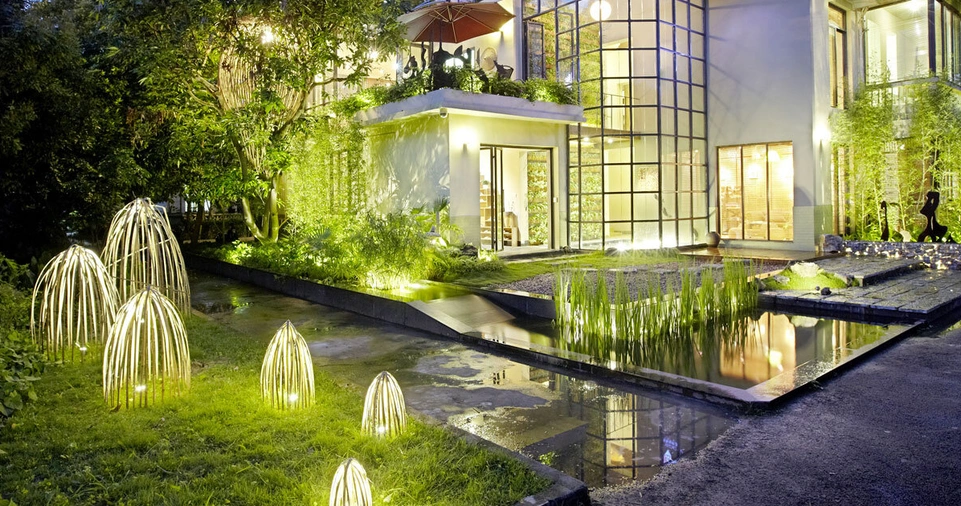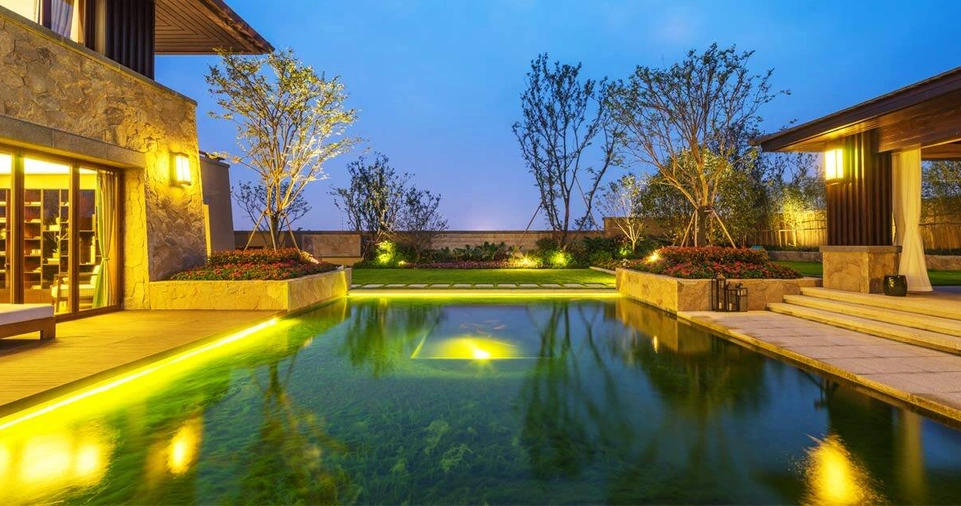Outdoor lighting plays a crucial role in showcasing the beauty and elegance of architectural features, enhancing curb appeal, and improving security.
By strategically placing lights around a building’s structure, homeowners and designers can highlight unique architectural elements, add depth, and create a visually appealing ambiance.
This guide explores various outdoor lighting techniques, types of fixtures, and best practices for illuminating architectural features.
Why Outdoor Lighting is Important for Architectural Features
Enhances Aesthetics
Well-placed outdoor lighting highlights the architectural details of a home or building, making it stand out at night.
It adds drama, depth, and warmth, creating a striking visual effect. Lighting can accentuate intricate facades, ornate moldings, and decorative trims that might go unnoticed during the day.
Improves Security and Safety
Proper outdoor lighting minimizes dark spots, deters intruders, and reduces the risk of accidents by illuminating pathways, stairs, and driveways.
Well-lit exteriors create a sense of safety for residents and visitors, preventing tripping hazards and discouraging potential break-ins.
Increases Property Value
A well-lit exterior enhances curb appeal, making a property more attractive to potential buyers and increasing its resale value.
Homes with professional outdoor lighting installations tend to have a higher perceived value, making them more appealing in real estate markets.
Creates an Inviting Ambiance
Strategically placed lights create a warm and welcoming atmosphere, enhancing the outdoor experience.
Whether for entertaining guests, dining al fresco, or simply enjoying the yard, outdoor lighting extends the usability of exterior spaces after sunset.
ALSO READ: How to Integrate Sustainable Tech into Your Home?
Types of Outdoor Lighting Techniques

Different lighting techniques help emphasize various architectural elements. Here are the most effective ones:
Uplighting
- Involves placing lights at ground level and angling them upwards to illuminate walls, columns, and facades.
- Ideal for highlighting tall architectural features such as pillars, statues, and textured surfaces.
- Works well for large trees and landscape focal points.
Downlighting
- Lights are placed high and directed downward to simulate natural lighting.
- Often used for entryways, patios, and pergolas to create a soft, welcoming ambiance.
- Helps improve security by casting a broad, gentle light over walkways and outdoor areas.
Grazing
- Involves placing lights close to a textured surface, such as brick walls or stone facades, to highlight their textures.
- Creates a dynamic interplay of light and shadow.
- Best suited for accentuating architectural materials like stone, wood, or stucco.
Silhouetting
- A backlighting technique that places a light source behind an object to create a dramatic silhouette.
- Works best with trees, sculptures, and architectural structures with distinct shapes.
- Adds depth and mystery to the overall landscape design.
Shadowing
- Similar to silhouetting, but the light source is placed in front of an object to cast a shadow on a wall.
- Adds depth and drama to the landscape.
- Effective for creating a soft, artistic look on outdoor surfaces.
Moonlighting
- Lights are installed high in trees and directed downward to mimic moonlight filtering through branches.
- Creates a soft, natural lighting effect.
- Enhances garden spaces and creates a romantic outdoor setting.
Path and Step Lighting
- Used to illuminate walkways, driveways, and staircases for safety and aesthetics.
- Enhances visibility and prevents tripping hazards.
- Can be achieved using bollard lights, embedded step lights, or stake-mounted path lights.
Washing
- Uses wide-beam lights to softly illuminate large surfaces, such as walls or fences.
- Produces an even glow without harsh shadows.
- Ideal for creating a warm, inviting exterior ambiance.
ALSO READ: How to Transform Your Home Office into a Productive Space?
Best Outdoor Lighting Fixtures for Architectural Features

| Lighting Fixture | Best Used For | Key Features |
|---|---|---|
| Spotlights | Highlighting statues, columns, and textured walls | Adjustable beam angles, bright illumination |
| Floodlights | Illuminating large facades and driveways | Wide beam coverage, high intensity |
| Wall Wash Lights | Enhancing walls and facades | Soft, uniform glow, energy-efficient |
| Step Lights | Lighting up stairs and pathways | Recessed, weather-resistant |
| Bollard Lights | Marking pathways and entrances | Sturdy, decorative designs |
| String Lights | Adding ambiance to patios and outdoor areas | Versatile, warm glow |
| In-Ground Lights | Uplighting trees and architectural elements | Discreet, waterproof |
| Lanterns | Traditional aesthetic for porches and patios | Classic design, diffused lighting |
| LED Strip Lights | Accentuating modern architecture | Flexible, energy-efficient |
ALSO READ: How to Prepare Your Home for a Real Estate Photography Session?
Choosing the Right Outdoor Lighting for Your Architecture
Consider the Architectural Style
- Modern homes benefit from sleek, minimalist lighting such as recessed lights and LED strips.
- Traditional homes look great with lantern-style fixtures and warm-toned bulbs.
- Industrial-style buildings suit exposed bulbs and metallic fixtures.
- Mediterranean or colonial homes look elegant with wrought-iron sconces and warm glow lanterns.
Focus on Key Architectural Features
- Entryways and doors: Use sconces or pendant lights to enhance the entrance.
- Columns and facades: Spotlights and wall washers work best.
- Windows and balconies: Subtle lighting, such as recessed or strip lights, maintains elegance.
- Landscaping: Integrate landscape lighting to complement the building’s exterior.
- Water features: Underwater LED lights can enhance fountains or ponds.
Choose Energy-Efficient Options
- LED lights consume less power and last longer compared to traditional bulbs.
- Solar-powered fixtures are eco-friendly and reduce electricity costs.
- Motion-sensor lights provide illumination only when needed, saving energy.
Opt for Weather-Resistant Fixtures
- Ensure fixtures are rated for outdoor use (IP65 or higher for wet locations).
- Materials like stainless steel, brass, and powder-coated aluminum offer durability.
- Corrosion-resistant coatings extend the lifespan of fixtures in humid or coastal environments.
ALSO READ: How to Use Mulch Effectively in Your Garden?
Installation Tips for Outdoor Architectural Lighting

Plan Your Lighting Layout
- Identify the focal points and decide on the lighting techniques to use.
- Balance brightness levels to avoid over-illumination or dark spots.
- Use smart lighting systems for automated controls.
Use Layered Lighting
- Combine multiple lighting techniques for a balanced effect.
- Mix ambient, task, and accent lighting for a well-lit exterior.
Avoid Light Pollution
- Use shields and louvers to direct light only where needed.
- Choose warm-toned bulbs (2700K–3000K) for a cozy atmosphere.
- Use timers and dimmers for better control over brightness levels.
Hire a Professional if Needed
- A lighting designer or electrician can ensure proper installation and electrical safety.
ALSO READ: How to Design an Eco-Friendly Outdoor Space?
Conclusion
Outdoor lighting is essential for enhancing architectural features, improving safety, and elevating the aesthetics of a property.
By selecting the right lighting techniques, fixtures, and installation strategies, homeowners and designers can create a visually stunning and functional outdoor space.
Thoughtful lighting choices transform any property into a nighttime masterpiece, adding elegance, security, and value.






